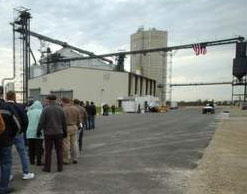 Students from the University of Colorado are spreading the good news of biodiesel… and going mobile to do it.
Students from the University of Colorado are spreading the good news of biodiesel… and going mobile to do it.
This story from the Colorado Daily says the CU Biodiesel program is using donated, used restaurant cooking oil in a production facility that is contained in a trailer:
“I’ve taught everyone from post-graduate students to second-graders how to brew their own biodiesel,” said CU senior Mike West, director of education for CU Biodiesel. “That’s the whole point of the project — to show people how easy it is to brew biodiesel.”
 The project West is referring to is a self-contained biodiesel trailer called ESTER, short for “fatty acid methylester,” or scientific name for biodiesel…
The project West is referring to is a self-contained biodiesel trailer called ESTER, short for “fatty acid methylester,” or scientific name for biodiesel…
According to CU junior Josh Jaffe, director of outreach for CU Biodiesel, both byproducts of the conversion go right back to the benefit of CU causes. The biodiesel is used by the Buff buses to transport students and the glycerine is donated to the CU Recycling Center to be used as a fertilizing agent for composting.
“This is going to be CU’s in-house, or in-parking lot, biodiesel production facility,” Jaffe said of ESTER, which began construction three years ago through a $46,000 grant from the CU Environmental Center.
The trailer is capable of producing 500 gallons of biodiesel a month, but more importantly, can go to schools to teach more people how to brew their own biodiesel.
CU is also holding a contest to come up with a winning design for the trailer. Students with ideas are invited to download a blank form and submit their ideas by November 19th at www.cubiodiesel.org.


 Iowa State University has received an $885,000 U.S. Department of Energy grant to see how small particles can be used to help make biodiesel production bigger.
Iowa State University has received an $885,000 U.S. Department of Energy grant to see how small particles can be used to help make biodiesel production bigger.
 “We walked through the B&I loan guarantee program, which has been used by their memberships, and we assured them that this was a long-standing program that we would use to help finance businesses in rural America, some of them may be ethanol facilities,” Schafer said. “We assured them that no specific money was being set aside only for the ethanol industry.”
“We walked through the B&I loan guarantee program, which has been used by their memberships, and we assured them that this was a long-standing program that we would use to help finance businesses in rural America, some of them may be ethanol facilities,” Schafer said. “We assured them that no specific money was being set aside only for the ethanol industry.” Inspiration for the design came from the legendary Cooper Climax F1 car of the 50’s and is drawing on Britain’s vast Motor Sport Heritage while keeping a firm eye to the future. It is not a retro car, it is a modern Super Car designed with the discerning enthusiast in mind. It is revolutionary and has been designed to set a new standard in the niche vehicle sports car market. The Climax is bespoke and exclusive, quintessentially British, hand-finished, with excellent performance and superb handling.
Inspiration for the design came from the legendary Cooper Climax F1 car of the 50’s and is drawing on Britain’s vast Motor Sport Heritage while keeping a firm eye to the future. It is not a retro car, it is a modern Super Car designed with the discerning enthusiast in mind. It is revolutionary and has been designed to set a new standard in the niche vehicle sports car market. The Climax is bespoke and exclusive, quintessentially British, hand-finished, with excellent performance and superb handling.  Speakers included USDA Undersecretary Tom Dorr; editor Morton Sosland of Sosland Publishing Co.; and Randy Schnepf, agricultural economist with the Congressional Research Service.
Speakers included USDA Undersecretary Tom Dorr; editor Morton Sosland of Sosland Publishing Co.; and Randy Schnepf, agricultural economist with the Congressional Research Service. The world’s largest ethanol producer opened a third plant in Ohio on Friday.
The world’s largest ethanol producer opened a third plant in Ohio on Friday.  The
The 
 Tampa, Florida could become a major port for alternative fuels… just in time as an area just up the road is expanding its potential to produce biodiesel.
Tampa, Florida could become a major port for alternative fuels… just in time as an area just up the road is expanding its potential to produce biodiesel.